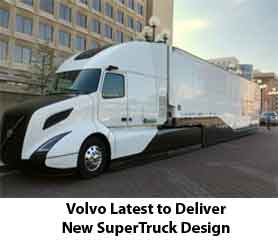For the past few years, the US Department of Energy has been running a "SuperTruck," program in which it is matching investment dollars with several major truck and engine manufacturers in an effort to gain substantial improvements in vehicle fuel efficiency.
Supply Chain Digest Says... |
|
|
Officially, the DOE says the program is about "expediting the development of advanced heavy-duty vehicle efficiency technologies." The DOE program has some $284 million in funding.
In mid-2014, a combination of engine maker Cummins and truck manufacturer Peterbilt announced significant progress, saying that testing for its SuperTruck design had demonstrated gains of more than 68% in freight efficiency over a 24-hour duty-cycle, a 50% improvement in freight efficiency on an 11-hour drive-cycle, and a 20% improvement in the thermal efficiency of the engine.
Freight efficiency is a measure of how much freight can be moved over a given distance by a given amount of fuel, using a metric of something like freight-tons moved per mile. That is considered a more meaningful number than miles per gallon because mpg by itself does not consider the weight of the freight being moved.
In early 2015, Daimler Trucks and its US brand Freightliner appeared to have upped the SuperTruck concept.
At the 2015 Mid-America Trucking Show in Kentucky, Daimler displayed its new prototype SuperTruck design, developed in partnership with engine maker Detroit Diesel and others. That truck exceeded the company's expectations, achieving freight efficiency improvement of a remarkable 115%, far above DOE's own goal of a gain of 50%.
More recently, the latest SuperTruck design was released by Volvo Trucks. As with the two previous SuperTruck efforts, the Volvo trucks offers some impressive gains:
• a freight efficiency improvement of 88%
• a 70% improvement in fuel economy (12-13 mpg) over a base model 2009 Volvo VNL 670 (which had 7 mpg performance)
• a net weight reduction of 3,200 pounds after adding the new mechanical and aerodynamic technology
• a 40% reduction in aerodynamic drag
• a 20% gain in powertrain thermal efficiency from 42% to 50%
(See More Below)
|
CATEGORY SPONSOR: SOFTEON |
|
|
| |
|
|
 Göran Nyberg, president of Volvo Trucks North America, called the SuperTruck project a "knowledge accelerator." Göran Nyberg, president of Volvo Trucks North America, called the SuperTruck project a "knowledge accelerator."
So that's all good, but will any of these SuperTrucks and their cool new technologies make it to market anytime soon? All the SuperTruck developers have noted that some of the components used in the prototype trucks may not be commercially viable at this point, for cost or performance reasons. In turn, some of that analysis depends on the price of diesel, which affects the ROI for truckers for some of the materials or other technology advances.
Volvo, for example, says some of the technologies on the truck are likely to remain wishful thinking for some time yet, such as carbon fiber body panels and a complex Rankine cycle waste-heat recovery system.
But the company says a number of innovations for its SuperTruck design will actually make it into its year 2017 model vehicles. Those improvements include some of the design elements that improve aerodynamics and a system to capture and convert heat energy into mechanical energy.
But assuming the preponderance of the gains are achievable and can be commercialized over the next few years, these SuperTruck-related developments may result in an inflection point in the logistics industry, substantially reducing trucking costs, doing the same thing for CO2 emissions per ton of freight moved, and altering the dynamics of truck versus rail decisions and the cost advantages of alternative fuel trucks - though many if not most of the improvements are likely achieved regardless of what fuel type is used.
Do you think these SuperTruck designs will see commercialiation any tme soon? Let us know your thoughts at the Feedback section below or the link above to send an email.
Your Comments/Feedback
|